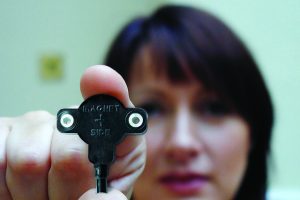
Debbie Rowland joined Charcroft Electronics as sales manager in 1993 and was appointed a director in 2015. The privately owned company reported revenue of £12.2m in 2022, up from £10.8m in 2021. The manufacturer and distributor of mechanical components, power and hi-rel semiconductors is based in Powys, Wales.
Even before the Covid pandemic, the industry was concerned about long lead times. This is still the case, says Rowland, but it is just different for various reasons, she says.
Lead times
“The upswing in orders pre-pandemic due to issues such as pre-empting Brexit, and transportation cost increases, drove OEMs to double order, to schedule out longer, and change their usual strategies. Then going into the pandemic, production by the big manufacturers was massively reduced, causing more panic buying. As demand slowed in some sectors, the panic of securing stock was then replaced by the panic of over-ordering and the manufacturers started to accept orders on a no cancellation, no return (NCNR) basis,” she says.
Now there are still long lead times, but what is different this time is that previously a lead time in excess of 52 weeks was considered ‘on allocation’ and orders would not be accepted.
Now there are many lead times in excess of 52 weeks and companies are dealing with this by carrying more stock and better forecasting of customers’ requirements, explains Rowland.
The industry is cautious about carrying too much inventory vs demand. Both contract electronics manufacturers and OEMs are more accepting of long lead times, Rowland points out. “If the longest lead time for a component specified is 52 weeks, for example, then everything else has to wait for that, cashflow must be one of the biggest issues for OEMs.”
She believes the excess inventory is mostly caused by the big OEMs double ordering on multiple manufacturers to see which can deliver first and, once confirmed, cancelling the longest lead time manufacturers. “This has been controlled more now by only accepting NCNR orders, which ensures commitment.” This practice is also seen in more broadline components, not speciality components, says Rowland. “There is also more pressure to reduce costs so customers are looking for the lowest cost components again rather than just getting supply,” she adds.
Specialisms
Charcroft operates in specialist areas, such as space, oil, gas and automotive. It distributes commercial, BS/CECC and Mil-Std passive, interconnect, electromechanical, power and hi-rel semiconductors. The company is certified to AS 9120 for aerospace and on the JOSCAR (Joint Supply Chain Accreditation Register) as a qualified supplier for companies in the aerospace, defence, security and space sectors. It is also approved to BS9000, IECQ-CECC and BS EN ISO9001:2015.

The facility in Llanwrtyd Wells manufactures custom passive assemblies, audio and precision foil resistors in addition to silver mica and legacy ceramic capacitors. The facility is a VPG-approved precision centre for VPG bulk metal foil resistors and offers taping and reeling as well as precision express manufacturing for prototype and pre-production quantities.
Design support
To help engineers optimise a specialist project with the components available, Rowland advocates broadening the specs as the best way to leave room to allow ‘better thans’ to be used such as higher specs, higher voltages, better tolerances. “The more specific a drawn-in part is, there is less leeway to source.” She also says it is important to understand the customer’s requirements. “In the space sector for example, in the earlier stages of design, the most qualified parts may not be required until the final build.”
Before the pandemic UK companies had to make provision for operating outside the EU, following the 2016 referendum. Charcroft prepared for this and Rowland is unphased by the post-Brexit business model. “Charcroft took the view to overstock so as not to be caught out by Brexit. What we still find is the delay in delivery from Europe and the complications of shipping into Europe, but we have a pretty good handle on this and it does not affect our customers,” she says.
Looking to the future
Another hurdle for the electronics industry generally is the skills shortage. Rowland explains the company’s approach to attracting staff to work in a company based in a scenic area of Wales.
“Charcroft invests in apprentices and training in the workplace,” she says. “We currently have five apprentices and two sales people doing electronics degrees with one day a week at college to encourage skills.”

Another approach is to hire staff who have a thirst for speciality components, she says. This interest and keenness to learn can often be transferred into any components in the electronics industry, says Rowland, particularly if they have an interest in, and are driven by, components that are not run of the mill.
Her advice to anyone considering a career in electronic component distribution is to work for a company that invests in its staff and look at what skills you can add. Working while learning and being enrolled on college or university courses is the best way forward, she adds.
Happy 50th anniversary
Charcroft was established in 1974 and is gearing up to celebrate 50 years of business next year. Although not at the company from the start, Rowland takes time to reflect on how the business she joined 30 years ago has changed. “[It has gone] From being owned and run by one person to now having over 90 staff.” (When she joined there were five members of staff.)
As the company grew, it allowed people to do the jobs they were good at, she says, and the result is the creation of a team of experts focused on keeping the customer happy.
As for any plans to mark half a century in business, she is keeping tight-lipped. “Just watch this space,” she teases.
 Electronics Weekly Electronics Design & Components Tech News
Electronics Weekly Electronics Design & Components Tech News



